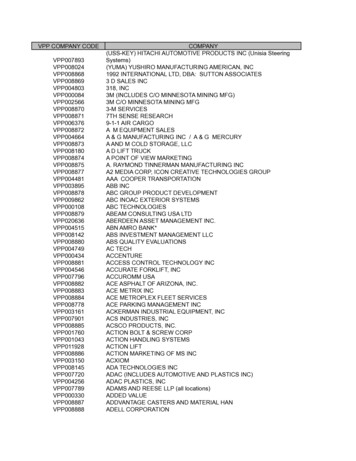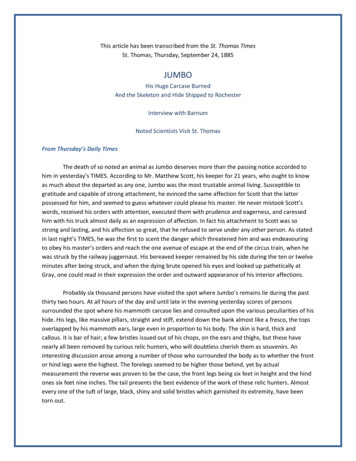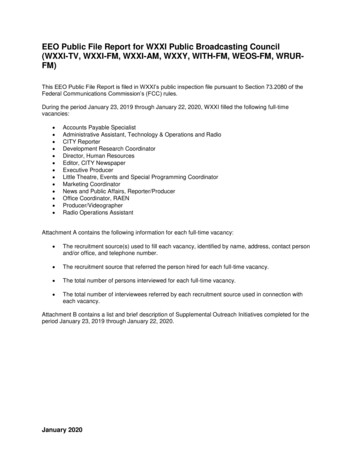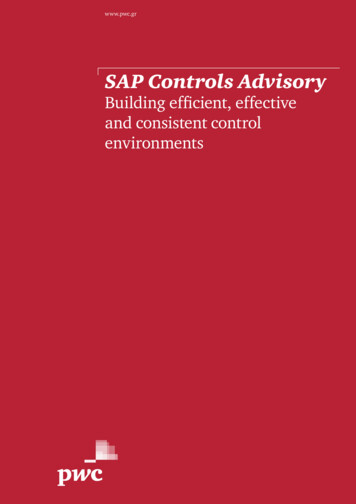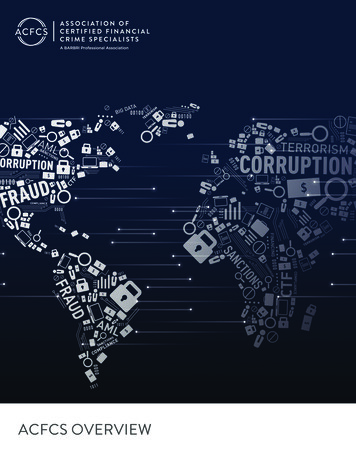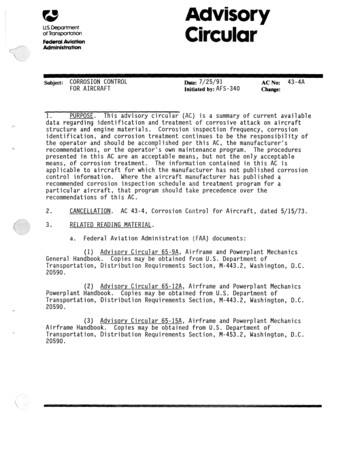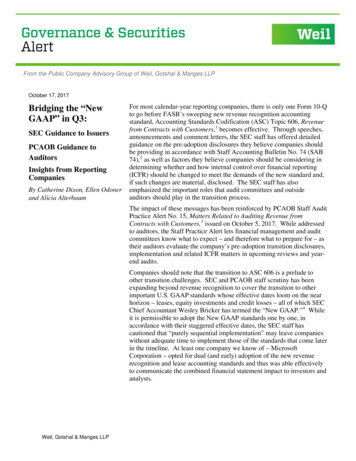
Transcription
From the Public Company Advisory Group of Weil, Gotshal & Manges LLPFrom the Public Company Advisory Group of Weil, Gotshal & Manges LLPOctober 17, 2017Bridging the “NewGAAP” in Q3:SEC Guidance to IssuersPCAOB Guidance toAuditorsInsights from ReportingCompaniesBy Catherine Dixon, Ellen Odonerand Alicia AlterbaumFor most calendar-year reporting companies, there is only one Form 10-Qto go before FASB’s sweeping new revenue recognition accountingstandard, Accounting Standards Codification (ASC) Topic 606, Revenuefrom Contracts with Customers, 1 becomes effective. Through speeches,announcements and comment letters, the SEC staff has offered detailedguidance on the pre-adoption disclosures they believe companies shouldbe providing in accordance with Staff Accounting Bulletin No. 74 (SAB74), 2 as well as factors they believe companies should be considering indetermining whether and how internal control over financial reporting(ICFR) should be changed to meet the demands of the new standard and,if such changes are material, disclosed. The SEC staff has alsoemphasized the important roles that audit committees and outsideauditors should play in the transition process.The impact of these messages has been reinforced by PCAOB Staff AuditPractice Alert No. 15, Matters Related to Auditing Revenue fromContracts with Customers, 3 issued on October 5, 2017. While addressedto auditors, the Staff Practice Alert lets financial management and auditcommittees know what to expect – and therefore what to prepare for – astheir auditors evaluate the company’s pre-adoption transition disclosures,implementation and related ICFR matters in upcoming reviews and yearend audits.Companies should note that the transition to ASC 606 is a prelude toother transition challenges. SEC and PCAOB staff scrutiny has beenexpanding beyond revenue recognition to cover the transition to otherimportant U.S. GAAP standards whose effective dates loom on the nearhorizon – leases, equity investments and credit losses – all of which SECChief Accountant Wesley Bricker has termed the “New GAAP.” 4 Whileit is permissible to adopt the New GAAP standards one by one, inaccordance with their staggered effective dates, the SEC staff hascautioned that “purely sequential implementation” may leave companieswithout adequate time to implement those of the standards that come laterin the timeline. At least one company we know of – MicrosoftCorporation – opted for dual (and early) adoption of the new revenuerecognition and lease accounting standards and thus was able effectivelyto communicate the combined financial statement impact to investors andanalysts.Weil, Gotshal & Manges LLP
Governance & SecuritiesIn this Alert, we cover the following topics:I.II.New GAAP in a nutshellSEC staff guidance for pre-adoption transition disclosureIII.Internal control considerations related to implementing New GAAPIV.Insights from transition disclosures by three reporting companiesV.VI.VII.VIII.IX.Anticipating post-adoption challengesThe audit committee’s role in the transition to New GAAPWhat to expect from the outside auditorPost-adoption relief and guidance from the SEC and its accounting staffPractical tips on “what to do now”I. New GAAP in a NutshellWe begin with a brief discussion, in the order of their effective dates, of each of the New GAAPstandards called out by the SEC’s accounting staff as particularly important from a companyreadiness perspective: revenue recognition (ASC 606); financial instruments – equity investments(ASC 825-10) 5; leases (ASC 842) 6; and financial instruments – credit losses (ASC 326) 7.Companies now wrestling with complex New GAAP implementation issues should note that theSEC’s Office of Chief Accountant (OCA) has expressed its continued willingness to engage in nonpublic, pre-filing consultations with individual companies, and has stressed that the staff has and willcontinue to accept reasonable judgments made by management in the application of these standards.Revenue Recognition – Effective January 1, 2018 for Calendar-Year Reporting CompaniesASC 606 creates a comprehensive new revenue recognition accounting model based on a coreprinciple: “an entity shall recognize revenue to depict the transfer of promised goods or services tocustomers in an amount that reflects the consideration to which the entity expects to be entitled inexchange for those goods or services.” 8 Superseding most (if not all) of FASB’s previous,sometimes industry-specific revenue recognition guidance, the new standard establishes five generalcriteria for recognizing revenue in accordance with this core principle: (1) identify the contract witha customer; (2) identify the performance obligations in the contract; (3) determine the transactionprice; (4) allocate the transaction price to the performance obligations in the contract; and (5)recognize revenue when (or as) the customer obtains control of that good or service. Extensive newquantitative and qualitative footnote disclosure also will be required.ASC 606 must be applied retrospectively under one of two basic transition methods: (1) fullretrospective, requiring restatement of revenues (and expenses) for all historical reporting periodspresented in the financial statements, subject to election of certain transitional “practical expedients”permitted by FASB; and (2) modified retrospective, which dispenses with restatement of prior-periodrevenue but requires a cumulative adjustment for the effects of the new standard upon adoption onthe effective date. As discussed under “Post-Adoption Relief and Guidance from the SEC and itsAccounting Staff” below, various types of relief, including relief to facilitate use of Form S-3, may beavailable to companies choosing the full retrospective method.Weil, Gotshal & Manges LLPOctober 17, 20172
Governance & SecuritiesFinancial Instruments/Equity Investments –Effective January 1, 2018 for Calendar-YearReporting CompaniesASC 825-10, a new accounting standard relating to the classification and measurement of financialinstruments, applies to both equity and debt investments. Companies appear to be most concernedabout the impact on net income of the equity portion of the new standard. 9 Equity investments, otherthan those accounted for using the equity method of accounting or those that result in consolidationof the equity investee, will be measured under ASC 825-10 at fair value on the balance sheet, withchanges in fair value recognized through net income. Companies whose minority equity investmentsdo not have a readily determinable fair value may elect a practicability exception allowingmeasurement of the value of these investments at cost minus impairment and plus or minusobservable price changes.Leases – Effective January 1, 2019 for Calendar-Year Reporting CompaniesThe expansive new lease accounting standard set forth in ASC 842 “will result in lessees recognizingmost leases on the balance sheet.” 10 Companies will have to evaluate as a potential lease, foraccounting purposes, any arrangement that conveys control over the use of an identified asset by oneparty (lessor) to another (lessee). Some leases are specifically excluded from the scope of ASC 842,such as those with terms of less than one year and certain leases involving, for example, intangibleassets and natural resources.Financial Instruments/Credit Losses – Effective January 1, 2020 for Calendar-Year ReportingCompaniesUnder ASC 326, companies will be required “to measure all expected credit losses for financialinstruments held at the reporting date based on historical experience, current conditions andreasonable and supportable forecasts.” 11 As SEC Chief Accountant Bricker noted in a recent speech,the scope of this New GAAP standard “crosses industries, consistent with the variety of financingarrangements businesses provide.” 12 By way of example, Mr. Bricker cited credit cards and otherforms of financing retailers typically offer to customers who buy their merchandise. Banks and otherfinancial institutions that extend credit anticipate a major impact on accounting for loan losses, giventhe shift away from the current “incurred loss” model permitting deferral of credit loss recognitionuntil deemed “probable.” 13II. SEC Staff Guidance for Pre-Adoption Transition DisclosureDuring a September 2016 meeting of FASB’s Emerging Issues Task Force (EITF), SEC AssistantDeputy Chief Accountant Jenifer Minke-Girard announced the staff’s position on the application ofSAB 74 to disclosures in the financial statement footnotes regarding the potential impact of adoptingthe new revenue recognition standard in a future period. 14 Since last fall, this guidance has beenexpanded to cover leases and financial instruments – the rest of the triumvirate of what the SECaccounting staff views as the most significant of the New GAAP standards. 15SAB 74 disclosure guidance recognizes that, at a given reporting date, company management maynot know, or may not be able to estimate reasonably, the financial statement impact of adopting anew accounting standard. Where this is the case, however, the guidance calls for this fact to bedisclosed in the footnotes to the financial statements and, as necessary or appropriate, inWeil, Gotshal & Manges LLPOctober 17, 20173
Governance & SecuritiesManagement’s Discussion and Analysis (MD&A); for example, as a “known material trend oruncertainty” and/or critical accounting estimate.In addition, the guidance calls for the following qualitative disclosures: The date of mandatory adoption of the new standard, and the date on which the company plans toadopt it, if earlier. Where there are alternatives (in the case of revenue recognition, full retrospective and modifiedretrospective), which transition method will be selected, if decided, and why that method hasbeen chosen. The status of the company’s implementation process. A description of any significant implementation issues that have not yet been addressed. The anticipated impact of the accounting policies the company plans to adopt, if known, and anexplanation of how these new policies may differ from current accounting policies (e.g., in termsof timing of revenue recognition; impact on particular revenue streams, such as licenses, giftcards, etc.). The potential impact of other significant matters the company believes might result fromadoption (e.g., tax accounting implications; planned or intended changes in business practices).The staff has expressed skepticism regarding the basis for blanket statements made by manycompanies to date that the financial statement impact of ASC 606 “is not expected to be material.”Noting that “the changes in the new revenue standard will impact nearly all companies,” the staff hasemphasized that the requisite materiality analysis must take into consideration ASC 606’s expansivenew footnote disclosures. This is because, “[e]ven in situations where the extent of change on thebalance sheet or income statement is not deemed to be material, the related disclosures may bematerial.” As the staff has explained:The scope of the new standard addresses not only amountsand timing of revenue but also new, comprehensive[financial statement footnote] disclosure about contractswith customers, including the significant reasonablejudgments the registrant has made when applying theguidance. Accordingly, the basis of any statement that theimpact of the new standard is immaterial should reflectconsideration of the full scope of the new standard, whichcovers recognition, measurement, presentation, anddisclosure. 16The SEC’s Division of Corporation Finance has been applying OCA’s SAB 74 disclosure guidancein the context of its review of periodic reports filed by individual companies. In this excerpt from arepresentative comment letter quoted in a report published by Deloitte in early September 2017, forexample, the staff challenged the sufficiency of a company’s statement that it was still in the processof evaluating the impact:“You state that you continue to make progress in evaluatingthe impact that the amended revenue recognition guidancein Topic 606 will have on your future consolidated financialstatements. We further note your disclosures in the Form10-Q appear to describe the approach you are undertaking inWeil, Gotshal & Manges LLPOctober 17, 20174
Governance & Securitiesyour analysis of the standard, without providing anunderstanding of any known potential impact or the currentstatus of your evaluation. Please revise to providequalitative financial statement disclosures of the potentialimpact that this standard will have on your financialstatements when adopted. In this regard, include adescription of the effects of the accounting policies that youexpect to apply, if determined, and a comparison to yourcurrent revenue recognition policies. Describe the status ofyour process to implement the new standard and thesignificant implementation matters yet to be addressed. Inaddition, to the extent that you determine the quantitativeimpact that adoption of Topic 606 is expected to have onyour financial statements, please also disclose such amounts.Please refer to ASC 250-10-S99-6 and SAB Topic 11.M.[i.e. SAB 74].” 17In late September 2017, OCA Deputy Chief Accountant Sagar Teotia delivered a speechunderscoring the staff’s expectation that SAB 74 disclosures will “become more informative to theusers of the financial statements” as the New GAAP effective dates draw inexorably closer:As SAB 74 intended, we expect companies to be transparentin their disclosure as to where the company is in itsimplementation progress. The SAB 74 disclosures areintended to inform a reader where the company is in itsimplementation progress. As the effective date nears, andfor companies that have not made sufficient progress, thisfact will become clear in the SAB 74 disclosures. This willallow relevant stakeholders such as audit committeemembers, auditors and investors to hold managementaccountable for determining how the company is going toimplement the new standards timely. 18Along with the disclosure implications of adopting a new standard itself, SEC staff accountants havealso emphasized that companies need to keep a watchful eye on the disclosure implications ofchanges made to ICFR in anticipation of adopting the standard. As the effective date of ASC 606 orother New GAAP nears, these changes may rise to the level of a “material change” in ICFR that mustbe disclosed in Item 4, Part I of Form 10-Q or Item 9A, Part II of Form 10-K. On the other hand, it isentirely possible that some companies that got an early start on evaluation and implementation of oneor more of the New GAAP may not have found it necessary to make related ICFR changes rising to adisclosable level within any given quarterly reporting period. For more on the staff’s views in thisarea, see “Internal Control Considerations Related to Implementing New GAAP” below.Weil, Gotshal & Manges LLPOctober 17, 20175
Governance & SecuritiesIII. Internal Control Considerations Related to Implementing NewGAAPSEC Chief Accountant Bricker and other OCA staff members have identified factors that theybelieve companies should consider in determining whether and how to update their ICFR systems asthey prepare for adoption of ASC 606. Companies should keep in mind that their outside auditorsalso will be considering these factors in conducting the integrated audit of their clients’ fiscal 2017financial statements and ICFR. See “What to Expect from the Outside Auditor,” below. Accounting Resources – Employees charged with applying ASC 606 must have the professionalcompetence to evaluate revenue arrangements and apply the principles of ASC 606 properly. Toensure this, companies “need to assess and continually reassess the impact [of the new standard]to their existing accounting and financial reporting competencies and make adjustments asappropriate to their training, retention and recruitment programs.” 19 Management Judgment – ASC 606 will require the application of significant managementjudgment, 20 thus “highlight[ing] the importance of a company’s control environment – setting theright ‘tone at the top’ and expectations for responsible conduct throughout the organization.” 21Under the oversight of the audit committee (see “The Audit Committee’s Role in the Transition toNew GAAP”), “[m]anagement should consider whether [ICFR] changes to support the formationof sound judgments are needed in applying the new standard[s].” It goes without saying thatmanagement should document the evidentiary support for judgments made in respect of thecompany’s transition to all of the New GAAP standards, in anticipation of the next integratedaudit of the annual financial statements and ICFR. Recognizing the inherent complexity of thistask, OCA Deputy Chief Accountant Teotia suggested taking a holistic approach toimplementation and post-adoption application of ASC 606, explaining thatthere are so many areas demanding managerial judgmentthat “it may be most effective and efficient to think aboutthe accounting, [footnote] disclosures, and ICFRconcurrently, including the disclosure of disaggregatedrevenue and the disclosure of remaining performanceobligations. For example, while a registrant is determiningthe accounting impact – that is, identifying its performanceobligations and estimating and allocating the transactionprice – a registrant should also consider how it plans todisaggregate revenue in order to depict how the nature,amount, timing and uncertainty of revenue and cash flowsare affected by economic factors. As a result of thisimportant judgment, a registrant may determine that the datawill have to be disaggregated in a manner different than haspreviously been disclosed. This could require systemchanges or obtaining data from different personnel – all ofwhich could be subject to new or different internal control.It takes time of course to implement internal controlchanges. This is one of the many reasons it is critical to stayon top of raising and resolving implementation andapplication issues. 22Weil, Gotshal & Manges LLPOctober 17, 20176
Governance & Securities Technology – Mr. Bricker pointed out, in a September 2017 speech focusing on the new creditlosses standard, that there are more technology options than ever to help companies prepare theirbooks and records and operate internal accounting control processes as they transition to the NewGAAP. He went on to note that “automated, preventive controls can offer certain benefits versusmanual, detective controls.” Along with the obvious benefits of technology, however, “there canalso be a shift in the nature of risk to be identified and addressed through internal controls.” 23The recent spate of corporate cyber-hacking attacks underscores the vulnerability of automatedfinancial reporting control systems, and the concomitant need for heightened security measures. Documentation – Mr. Bricker also reminded management that “[d]ocumentation can facilitatethe retention or transfer of knowledge useful in resolving discussions more quickly related tothings like the identification and assessment of risks, control design, testing strategy, andevaluation of deficiencies.” To illustrate, he observed that “sufficiently detailed controldescriptions can support the quality and consistency of control operation, particularly where thereis judgment in the execution.” 24 Internal Communications – Companies also should assess the financial reporting implications ofchanges that may be made to their established business practices during the transition period,such as changes to customer contracts. Because of the unprecedented level of disaggregatedfootnote disclosure that will be required, application of ASC 606 may call for the collection,sharing and analysis of new and different types of information throughout the entire organization.Accordingly, “it will be important to take a fresh look at the informati
SAB 74 disclosure guidance recognizes that, at a given reporting date, company management may not know, or may not be able to estimate reasonably, the financial statement impact of adopting a new accounting standard. Where this is

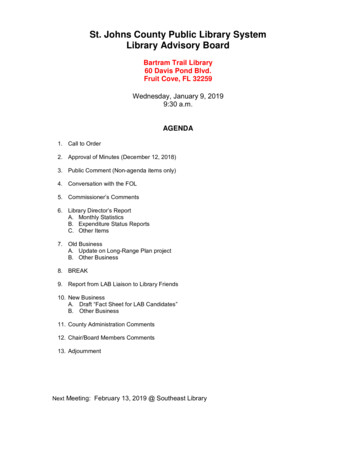
![Shareholders’ Agreement of [Company name] company. 1 .](/img/1/startup-founders-sha-sample.jpg)
